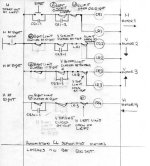richard0956
Member
Hi. I've got to a stage where I am able to draw a ladder circuit involving relays which will send a horizontal gantry on rails to the right end stop, then after a second automatically reverse the gantry back to the horizontal home position.
Of course I employed limit switches on both ends of the rails.
But, I'm getting stuck progressing to automating two gantries.
Say I have two gantries - vertical (V) and horizontal (H). I want to push a start button: The H gantry moves to right end stop and stops, then the V gantry moves down to bottom end stop, then after a second, goes back to top end stop, at which point the H gantry moves back to home position.
The problem I have is this: By what means does the machine know when to start moving the H gantry back to home position?
In other words, how does the machine differentiate between a home position (V gantry at top end stop) of the V gantry before it starts out on it's journey (down and back again) and the home position after the V gantry has completed it's journey?
Thanks.
Of course I employed limit switches on both ends of the rails.
But, I'm getting stuck progressing to automating two gantries.
Say I have two gantries - vertical (V) and horizontal (H). I want to push a start button: The H gantry moves to right end stop and stops, then the V gantry moves down to bottom end stop, then after a second, goes back to top end stop, at which point the H gantry moves back to home position.
The problem I have is this: By what means does the machine know when to start moving the H gantry back to home position?
In other words, how does the machine differentiate between a home position (V gantry at top end stop) of the V gantry before it starts out on it's journey (down and back again) and the home position after the V gantry has completed it's journey?
Thanks.
Last edited:





